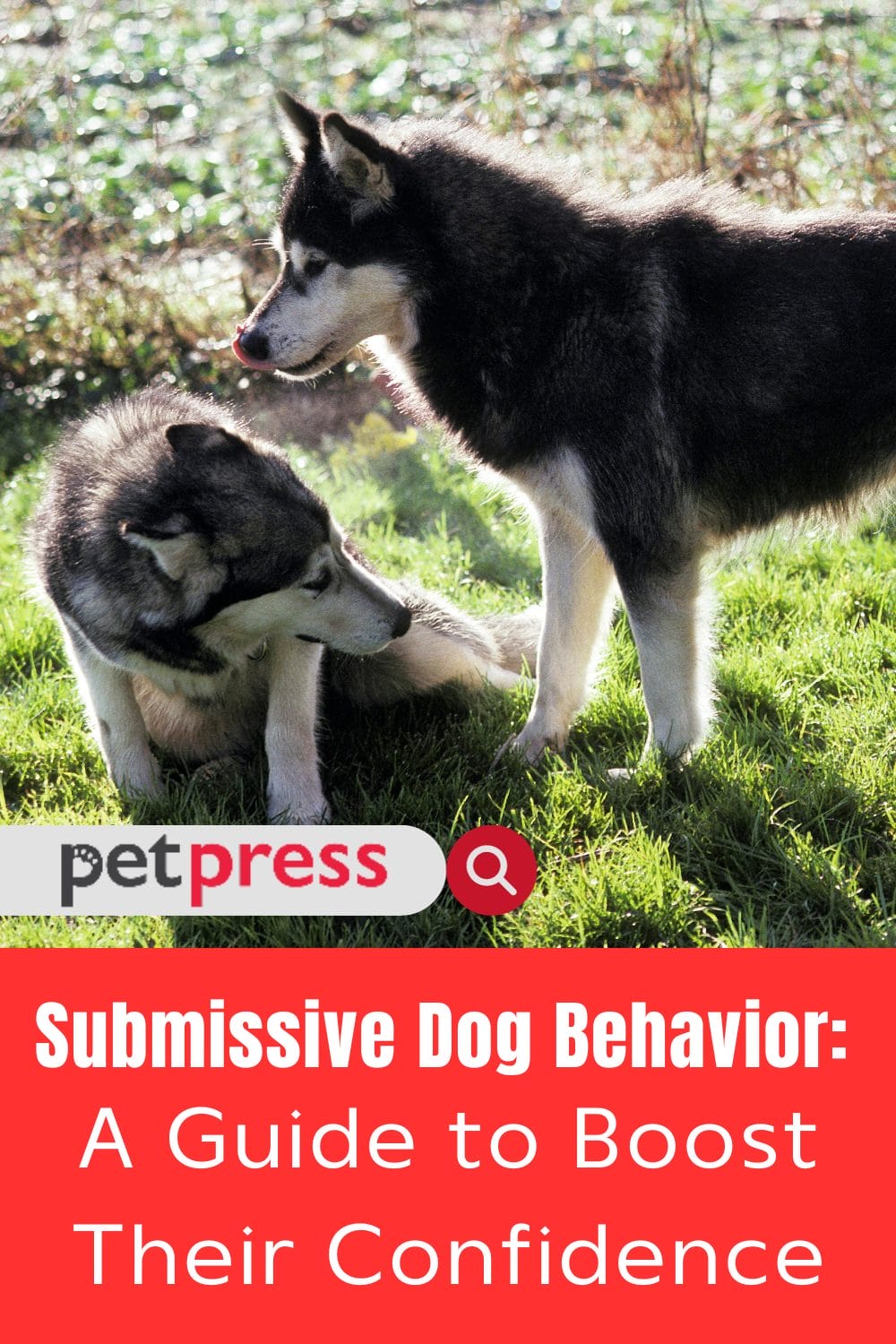
Welcome, dear dog lovers! Ever witnessed your furry friend tuck its tail, avoid eye contact, or even urinate when you or someone else approaches? If yes, then you’ve had a front-row seat to the canine theater of submissive dog behavior.
But fret not! This is not a permanent act in the doggie drama. It’s high time we shine a spotlight on this misunderstood part of the canine psyche.
Submissive behavior in dogs is a natural response that stems from their pack-oriented nature. Understanding and addressing this behavior is crucial for fostering a healthy and confident canine companion.
So, grab a dog biscuit, huddle up with your four-legged friend, and let’s embark on this enlightening journey to transform your submissive pooch into a confident, tail-wagging superstar.

What is submissive behavior in dogs?
Submissive behavior is characterized by a dog’s inclination to yield to perceived authority figures, be they other dogs or humans. These are the actions and postures a dog uses to avoid conflict, show respect, or react to perceived threats or stressful situations.
This behavior is an instinctual tactic used by dogs to maintain peace and avoid confrontations in social scenarios. However, consistent or intense submissive behavior in your canine friend might be indicative of underlying issues such as anxiety, lack of confidence, or past trauma.
It’s essential to identify and address these signs early, helping your furry friend gain confidence and live a happy, well-adjusted life.
Submissive Behavior vs Fear-based Behavior
Signs of submissive behavior may include tail tucking, cowering, ears held back, and a reluctance to make direct eye contact.
It’s essential to differentiate between submission and fear-based behavior to respond appropriately. Though submissive behavior and fear-based behavior can appear similar, they stem from different psychological states in your dog.
A dog displaying submissive behavior is trying to communicate respect, deference, or appeasement, and the behavior often surfaces during social interactions. These dogs might offer a ‘submissive grin‘, expose their belly, or lower their body posture, signaling that they acknowledge another’s dominance.
On the other hand, fear-based behavior signifies that a dog is feeling threatened or scared. Fearful dogs may also show signs of submissive behavior, like tucking their tail or cowering. But these are usually coupled with more intense signs like trembling, whining, or trying to escape, and defensive aggression.
A fearful dog is reacting out of panic and perceived danger, while a submissive dog is communicating their position in the social hierarchy. These differences can help you better respond to your dog’s needs, helping them feel safe, secure, and confident.

Causes of Submissive Behavior
Early Socialization
Dogs that weren’t adequately socialized during their formative months may exhibit heightened submissive tendencies. Limited exposure to various environments, people, and other dogs can lead to apprehension.
Past Trauma
Dogs with a history of abuse or neglect may display submissive behavior as a coping mechanism. Building trust through patience and positive interactions is key in such cases.
Breed Predispositions
Certain breeds are more prone to submissive behavior due to their genetic makeup. Recognizing these predispositions can guide your approach to nurturing confidence.
Impact on Canine Well-being
Physical Health
Submissive behavior in dogs can impact their physical health, particularly if it stems from fear or anxiety.
Submissive dogs often experience high stress levels, which can lead to health complications. It weakens the immune system, making them more susceptible to infections and diseases. It can also lead to behavioral issues like excessive licking and chewing, which can lead to skin problems or injuries.
Additionally, submissive dogs may not engage in sufficient physical activity due to their lack of confidence, potentially leading to obesity-related issues such as heart disease and joint problems.
Emotional Well-being
Submissive dogs face a constant battle with anxiety, fear, and low self-esteem, which can greatly impact their overall well-being. Their lack of confidence leads to heightened sensitivity in their interactions and surroundings.
In addition, submissive dogs may encounter challenges in forming healthy, balanced relationships with other dogs and humans. Their constant need to display deference can hinder genuine interactions. Ultimately, this can significantly impact their quality of life.
Being a responsible dog owner means appreciating the emotional rollercoaster of submissive behavior. By understanding this, we can be the supportive partners our furry friends need to conquer their anxieties and wag their way to confident lives.

5 Best Techniques for Effective Empowerment of Submissive Dogs
Positive Reinforcement
Reward-based training methods are highly effective in boosting confidence. Encouraging and rewarding independent actions fosters a sense of accomplishment.
Positive reinforcement involves rewarding your dog for displaying desired behaviors, increasing the likelihood of repeated behaviors. For instance, if your dog maintains calm during a stressful situation, like the arrival of a visitor, reward them with a treat or their favorite toy.
Similarly, if they successfully interact with another dog without showing excessive submission, give them praise or a gentle pat to acknowledge their accomplishment. If your dog makes direct eye contact with you without anxiety, offer them a treat while maintaining eye contact.
Remember, the key to successful positive reinforcement is consistency and timing. Rewards should be given immediately following the desired behavior, ensuring your dog associates the reward with their action.
Gradual Exposure
Gradual exposure to new environments, people, and experiences builds confidence over time. Patience is vital, as pushing too quickly can exacerbate submissive tendencies.
Gradual exposure can help desensitize your anxious or fearful dog to triggers and build confidence. Examples include:
- New People: Start by introducing them to a friend in a calm and controlled environment. Allow your friend to be in the same space without demanding interaction from your dog. Over time, as your dog gets comfortable, your friend can initiate mild interactions like offering treats.
- New Environments: If unfamiliar environments cause stress, start by introducing your dog to a new room in your home. Bring their favorite toys, beds, or blankets to make the space feel familiar. As they adjust, start taking them on drives or walks in new neighborhoods.
- Other Dogs: If interactions with other dogs trigger submissiveness, start with one-on-one playdates with a friendly, calm dog. Let them interact under your supervision and ensure it’s a positive experience for your dog by providing treats, praise, and affection.
Remember, gradual exposure means proceeding at your dog’s pace. A rushed approach could potentially heighten their anxiety, so patience and consistency are crucial to success with this technique.
Building Confidence through Play
Engaging in interactive play strengthens the bond between you and your dog. It also provides opportunities for them to assert themselves positively and playfully.
Playing games with your dog stimulates them physically and mentally, bolstering their confidence. Here are some examples:
- Fetch: A classic game of fetch can work wonders for a submissive dog. When your dog retrieves the toy and gives it back to you, shower them with praise and treats. This simple game can boost their self-esteem.
- Tug-of-war: Tug-of-war can be a healthy game for dogs if played correctly. It allows your dog to exert its strength in a controlled manner. Make sure to let your dog win occasionally to build their confidence.
- Hide and Seek: This fun game improves your dog’s problem-solving skills. It’s a fun way to reinforce the bond between you and your dog, and the excitement of finding you can boost their confidence.
- Agility Training: Setting up a simple agility course at home with tunnels, ramps, and poles for your dog to navigate can be a fun way to boost their confidence. Start small and gradually increase the complexity of the course as your dog becomes more confident.
- Trick Training: Teaching your dog new tricks can build confidence. Start with simple tricks like ‘sit,’ ‘stay,’ ‘shake hands,’ and reward them generously when they get it right. This process can help your dog understand that they are capable.
Remember, these games aim to make your dog feel good about themselves. So, it’s essential to keep the sessions positive and stress-free. Be patient, provide positive reinforcement, and, most importantly, have fun!

Consistent Daily Routine
Consistency in training and interactions is paramount. It should extend to all aspects of your dog’s life, from their daily routine to interactions with others.
Establishing a consistent daily routine for your dog creates a sense of stability. Ensure that meal times, walks, playtime, and training sessions occur regularly.
This predictability can help reduce anxiety and build confidence in your dog. A predictable environment helps your dog build trust and confidence in their abilities.
Celebrate Progress
Recognize and celebrate even the smallest signs of increased confidence. This positive reinforcement reinforces their progress and encourages further growth. Keep a journal to track their progress and note any positive changes in behavior.
Examples of Celebrating Progress
Celebrating progress can take many forms. Here are some fun and rewarding ways to acknowledge your dog’s steps toward overcoming submissive behavior:
- Photo Documentation: Take regular photos of your dog during their confidence-building activities. Over time, you’ll have a visual record of their improvements. It’s also a fun way to share their journey with your friends and family on social media, reinforcing the positive changes they have achieved.
- Special Treats: Offer a special treat following a successful interaction or behavior. If your dog has interacted positively with a new person or successfully navigated a new environment, reward them with their favorite treat. This not only celebrates their success but also reinforces the desired behavior.
- Extra Playtime: Reward your dog with additional playtime. For every small achievement, spend an extra few minutes playing their favorite game. It’s a great way to express your joy and pride in their progress.
- Happy Dance: Yes, you read it right! Dogs are very attuned to their owner’s emotions. So, when they do something great, show your excitement by doing a happy dance. Your dog will likely join in the fun, reinforcing their positive behavior.
- Affectionate Gestures: Show your dog some extra love when they make progress. A good belly rub, an extended cuddle, or a gentle, comforting massage can make your dog feel loved and appreciated.
Each dog has unique preferences, so the most effective approach will vary. It’s important to express your happiness and pride in their progress.

Seeking Professional Guidance
For severe submissive behavior, seek help from a dog trainer or behaviorist. Each dog is unique, so what works for one may not work for another. A professional can provide tailored strategies to manage submissive behavior.
For severe submissive behavior, seek help from a dog trainer or behaviorist. Each dog is unique, so what works for one may not work for another. A professional can provide tailored strategies to manage submissive behavior.
It’s here that the expertise of professional dog trainers or behaviorists becomes invaluable. These professionals are equipped with extensive knowledge and training in dog behavior, allowing them to devise strategies tailored to your pet’s specific needs.
Nuanced understanding professionals can provide deeper insights into your dog’s reactions, explaining the subtleties that an untrained eye may miss. They can help you understand the root cause of your dog’s behavior, allowing you to address the issue more effectively.
Moreover, professional guidance ensures that the interactions and training methods used are safe and effective. Misinterpretation of dog behavior and incorrect training methods can inadvertently exacerbate the issue rather than resolve it.
Acknowledging and addressing submissive behavior in dogs is essential, but seeking professional help when necessary is equally important. The ultimate goal is to ensure the well-being and happiness of your pet, and professional assistance can be a valuable tool in achieving this.
Conclusion
Understanding and addressing submissive behavior in dogs is vital to responsible pet ownership. You can help your canine companion flourish into a confident, happy family member by providing a supportive and nurturing environment.

FAQs
Can submissive behavior be eliminated in dogs?
Submissive behavior in dogs is a part of their communication system, but excessive or inappropriate behavior can be managed. Remember, each dog is unique, influenced by breed, age, health, and past experiences. Consult a professional dog behaviorist or trainer for tailored strategies to improve your dog’s confidence.
How can I differentiate between submission and fear-based behavior?
Submissive behavior involves showing respect and acknowledging dominance, while fear-based behavior responds to perceived danger or threat. Understanding these differences is crucial for interpreting your dog’s emotions and providing appropriate support.
Is it possible for older dogs to overcome submissive tendencies?
Yes, older dogs can overcome submissive tendencies. However, it may require more patience and consistent training compared to puppies. As always, seeking professional guidance can significantly assist in this process.
What role does breed play in a dog’s predisposition to submissive behavior?
The breed may have a role in submissive behavior in dogs due to genetics and traits. Certain breeds may be perceived as more submissive. Additionally, past experiences and training can greatly influence a dog’s behavior.
When should I seek professional help for my dog’s submissive behavior?
Seeking professional help is crucial if the submissive dog behavior is causing concern or impacting their well-being. It is proactive step towards enhancing your dog’s behavior and overall happiness, especially if previous training attempts have been unsuccessful.


GIPHY App Key not set. Please check settings